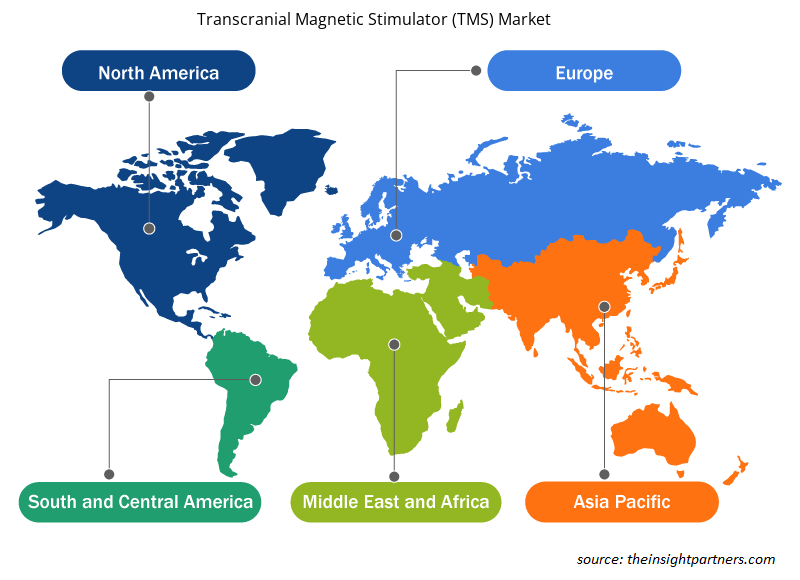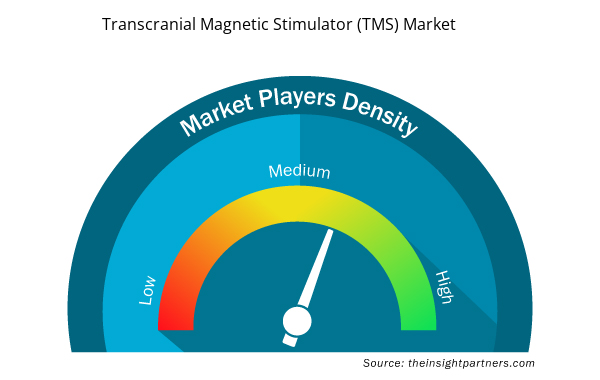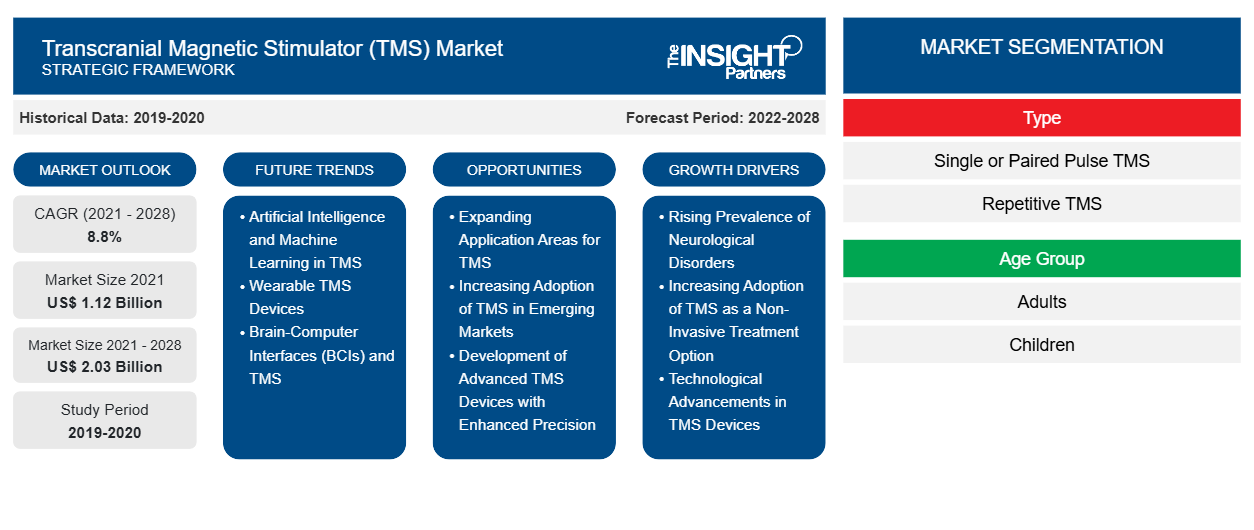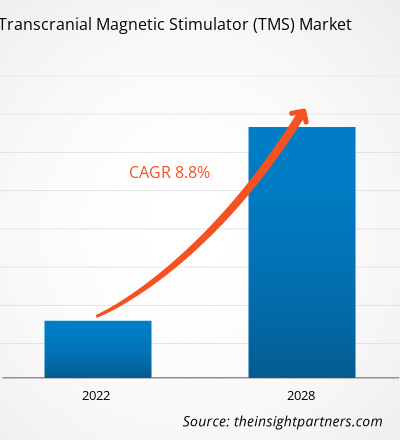[研究报告]经颅磁刺激器(TMS)市场规模预计将从 2021 年的 11.2222 亿美元增至 2028 年的 20.2971 亿美元;预计2021 年至 2028 年的复合年增长率为 8.8%。
神经系统疾病影响人体的大脑和神经,并导致癫痫和癫痫发作、帕金森病、痴呆、自闭症、阿尔茨海默病、脑瘤和脑瘫等。神经系统疾病的患病率在世界范围内呈上升趋势。根据 2017 年全球疾病负担研究 ( GBD ),就总伤残调整生命年 ( DALY )而言,阿尔茨海默病和其他痴呆症[255 万DALY ]、中风[约 358 万DALY ]和偏头痛(约 240 万DALY)是美国负担最重的三种神经系统疾病。
此外,阿尔茨海默病协会估计,超过 600 万美国人患有阿尔茨海默病,预计到 2050 年这一数字将达到近 1300 万。经颅磁刺激器( TMS ) 广泛用于诊断和治疗神经系统疾病。例如,根据BrainsWay Ltd. 的数据,2021 年 4 月,全球有 100,000 名患者接受了其深部TMS治疗。因此,神经系统疾病的日益流行推动了全球经颅磁刺激器( TMS ) 市场的增长。此外,抑郁症是全世界常见的精神疾病之一。根据世卫组织 2020 年 1 月发布的数据,全世界各年龄段的人有超过 2.64 亿人患有抑郁症。
定制此报告以满足您的需求
您可以免费定制任何报告,包括本报告的部分内容、国家级分析、Excel 数据包,以及为初创企业和大学提供优惠和折扣
- 获取此报告的关键市场趋势。这个免费样品将包括数据分析,从市场趋势到估计和预测。
市场洞察
经颅磁刺激 ( TMS ) 是一种非侵入性治疗神经系统疾病的方法。此外,TMS技术的不断发展也增加了其应用范围。在经颅磁刺激器( TMS ) 市场运营的公司正在采取各种策略,例如获得食品和药物管理局 (FDA) 对其创新产品的批准、建立业务合作伙伴关系以及为产品开发筹集资金,从而推动市场增长。
以下列出一些发展实例:
- 2021 年 3 月,MagVenture推出了MagVenture Flow Arm,这是一款正在申请专利的临床定位系统,旨在优化MagVenture 经 FDA 批准的非侵入性脑刺激技术协议的交付,用于治疗重度抑郁症和作为强迫症 ( OCD )的辅助疗法。
- 2020 年 8 月,MagVenture TMS疗法获得 FDA 批准用于强迫症的辅助治疗。这是丹麦医疗器械公司MagVenture在美国获得的第二项适应症。
- 2019 年 2 月,私营医疗技术公司eNeura , Inc. 宣布获得 FDA 新的 510(k) 批准。凭借此项批准,该公司声称sTMS是美国唯一一款用于治疗成人和儿童(12 岁及以上)急性和预防性偏头痛的偏头痛产品。
因此,全球参与者积极参与经颅磁刺激和相关技术的开发有望支持市场增长。
基于类型的洞察
根据类型,经颅磁刺激器 (TMS) 市场细分为单脉冲或双脉冲 TMS 和重复 TMS (rTMS)。2021 年,单脉冲或双脉冲 TMS 细分市场占据了较大的市场份额。然而,预计重复 TMS (rTMS) 细分市场在 2021-2028 年期间的复合年增长率会更高。
基于应用的洞察
根据应用,市场细分为研究、诊断和治疗。2021 年,诊断领域占据了最大的市场份额,预计未来几年将以最高的复合年增长率增长。
经颅磁刺激器 (TMS) 市场的公司强调采用产品创新战略来满足全球不断变化的客户需求,这也使他们能够在全球市场上保持自己的品牌名称。
经颅磁刺激器市场报告范围
经颅磁刺激器 (TMS) 市场区域洞察
Insight Partners 的分析师已详细解释了预测期内影响经颅磁刺激器 (TMS) 市场的区域趋势和因素。本节还讨论了北美、欧洲、亚太地区、中东和非洲以及南美和中美洲的经颅磁刺激器 (TMS) 市场细分和地理位置。

- 获取经颅磁刺激器 (TMS) 市场的区域特定数据
经颅磁刺激器 (TMS) 市场报告范围
| 报告属性 | 细节 |
|---|---|
| 2021 年市场规模 | 11.2亿美元 |
| 2028 年市场规模 | 20.3亿美元 |
| 全球复合年增长率(2021 - 2028) | 8.8% |
| 史料 | 2019-2020 |
| 预测期 | 2022-2028 |
| 涵盖的领域 | 按类型
|
| 覆盖地区和国家 | 北美
|
| 市场领导者和主要公司简介 |
|
市场参与者密度:了解其对商业动态的影响
经颅磁刺激器 (TMS) 市场正在快速增长,这得益于终端用户需求的不断增长,这些需求源于消费者偏好的不断变化、技术进步以及对产品优势的认识不断提高等因素。随着需求的增加,企业正在扩大其产品范围,进行创新以满足消费者的需求,并利用新兴趋势,从而进一步推动市场增长。
市场参与者密度是指在特定市场或行业内运营的企业或公司的分布情况。它表明在给定市场空间中,相对于其规模或总市场价值,有多少竞争对手(市场参与者)存在。
在经颅磁刺激器 (TMS) 市场运营的主要公司有:
- BrainsWay 有限公司
- 奈克斯汀
- 玛格斯汀
- 神经元学
- TMS 神经解决方案
免责声明:上面列出的公司没有按照任何特定顺序排列。

- 获取经颅磁刺激器 (TMS) 市场顶级关键参与者概览
经颅磁刺激器 (TMS) 市场 – 细分
按类型
- 单脉冲或双脉冲 TMS
- 重复性经颅磁刺激 (rTMS)
按年龄组
- 成年人
- 孩子们
按应用
- 研究
- 诊断
- 治疗
按地理位置
- 北美
- 我们
- 加拿大
- 墨西哥
- 欧洲
- 法国
- 德国
- 意大利
- 英国
- 西班牙
- 欧洲其他地区
- 亚太地区 (APAC)
- 中国
- 印度
- 韩国
- 日本
- 澳大利亚
- 亚太地区其他地区
- 中东和非洲 (MEA)
- 南非
- 沙特阿拉伯
- 阿联酋
- MEA 其他地区
- 南美洲和中美洲(SCAM)
- 巴西
- 阿根廷
- 其余的骗局
公司简介
- BrainsWay 有限公司
- Nexstim、Magstim
- 神经元学
- TMS 神经解决方案
- MagVenture 公司
- eNeura 公司
- 神经软件
- MAG & More 有限公司
- 历史分析(2 年)、基准年、预测(7 年)及复合年增长率
- PEST 和 SWOT 分析
- 市场规模价值/数量 - 全球、区域、国家
- 行业和竞争格局
- Excel 数据集



Report Coverage
Revenue forecast, Company Analysis, Industry landscape, Growth factors, and Trends

Segment Covered
This text is related
to segments covered.

Regional Scope
North America, Europe, Asia Pacific, Middle East & Africa, South & Central America

Country Scope
This text is related
to country scope.
常见问题
Asia Pacific is expected to be the fastest-growing region and is likely to expand at a high growth rate due to large geriatric population, rising numbers of neurological disorders are among the factors expected to drive the market in the region during the forecast period.
The global Transcranial Magnetic Stimulator (TMS) market based on type is segmented into Single or paired pulse TMS and Repetitive TMS (rTMS). In 2021, the Single or paired pulse TMS segment held the largest share of the market, by type. The Repetitive TMS (rTMS) segment of Transcranial Magnetic Stimulator (TMS) market is also expected to witness fastest CAGR during 2021 to 2028..
The Transcranial Magnetic Stimulator (TMS) market majorly consists of the players such as BrainsWay Ltd, Nexstim, Magstim, Neuronetics, TMS Neuro Solutions, MagVenture, Inc., eNeura Inc., Neurosoft, MAG & More GmbH. REMED among others amongst others.
The US is the largest market for Transcranial Magnetic Stimulator (TMS) at a global level. The US is the largest and fastest-growing market for the TMS market. The market growth is attributed to increasing developments of the medical device sector for neuromodulation, significantly rising incidences of neurological disorders among people and growing demand for neuromodulation devices for chronic pain management. In addition, the economic burden to treat neurological disorders is significantly growing in the country. For instance, according to a study published by the American Neurological Association in March 2017, ~US$ 800 billion is spent per year for treating neurological disorders. The cost of treatment affects ~100 million people every year across the country. It is also estimated that the treatment cost of dementia and stroke alone is estimated to reach over US$ 600 billion in 2030.
The factors that are driving and restraining factors that will affect Transcranial Magnetic Stimulator (TMS) market in the coming years. Factors such as rising prevalence of neurological disorders, growing developments in transcranial magnetic stimulation technology are driving the market growth. However, high cost of diagnostic and treatment are likely to hamper the growth of the market.
Transcranial Magnetic Stimulator (TMS), also referred to us repetitive Transcranial Magnetic Stimulator (rTMS), is a type of brain stimulation in which a changing magnetic field is applied to a specific area of the brain. An electric pulse stimulator is attached to a magnetic coil, which is then connected to the scalp. It is a non-invasive procedure and is used for diagnostic and therapeutic applications.
Trends and growth analysis reports related to Life Sciences : READ MORE..
The List of Companies - Transcranial Magnetic Stimulator (TMS) Market
- BrainsWay Ltd
- Nexstim
- Magstim
- Neuronetics
- TMS Neuro Solutions
- MagVenture, Inc.
- eNeura Inc.
- Neurosoft
- MAG & More GmbH.
- REMED
The Insight Partners performs research in 4 major stages: Data Collection & Secondary Research, Primary Research, Data Analysis and Data Triangulation & Final Review.
- Data Collection and Secondary Research:
As a market research and consulting firm operating from a decade, we have published and advised several client across the globe. First step for any study will start with an assessment of currently available data and insights from existing reports. Further, historical and current market information is collected from Investor Presentations, Annual Reports, SEC Filings, etc., and other information related to company’s performance and market positioning are gathered from Paid Databases (Factiva, Hoovers, and Reuters) and various other publications available in public domain.
Several associations trade associates, technical forums, institutes, societies and organization are accessed to gain technical as well as market related insights through their publications such as research papers, blogs and press releases related to the studies are referred to get cues about the market. Further, white papers, journals, magazines, and other news articles published in last 3 years are scrutinized and analyzed to understand the current market trends.
- Primary Research:
The primarily interview analysis comprise of data obtained from industry participants interview and answers to survey questions gathered by in-house primary team.
For primary research, interviews are conducted with industry experts/CEOs/Marketing Managers/VPs/Subject Matter Experts from both demand and supply side to get a 360-degree view of the market. The primary team conducts several interviews based on the complexity of the markets to understand the various market trends and dynamics which makes research more credible and precise.
A typical research interview fulfils the following functions:
- Provides first-hand information on the market size, market trends, growth trends, competitive landscape, and outlook
- Validates and strengthens in-house secondary research findings
- Develops the analysis team’s expertise and market understanding
Primary research involves email interactions and telephone interviews for each market, category, segment, and sub-segment across geographies. The participants who typically take part in such a process include, but are not limited to:
- Industry participants: VPs, business development managers, market intelligence managers and national sales managers
- Outside experts: Valuation experts, research analysts and key opinion leaders specializing in the electronics and semiconductor industry.
Below is the breakup of our primary respondents by company, designation, and region:

Once we receive the confirmation from primary research sources or primary respondents, we finalize the base year market estimation and forecast the data as per the macroeconomic and microeconomic factors assessed during data collection.
- Data Analysis:
Once data is validated through both secondary as well as primary respondents, we finalize the market estimations by hypothesis formulation and factor analysis at regional and country level.
- Macro-Economic Factor Analysis:
We analyse macroeconomic indicators such the gross domestic product (GDP), increase in the demand for goods and services across industries, technological advancement, regional economic growth, governmental policies, the influence of COVID-19, PEST analysis, and other aspects. This analysis aids in setting benchmarks for various nations/regions and approximating market splits. Additionally, the general trend of the aforementioned components aid in determining the market's development possibilities.
- Country Level Data:
Various factors that are especially aligned to the country are taken into account to determine the market size for a certain area and country, including the presence of vendors, such as headquarters and offices, the country's GDP, demand patterns, and industry growth. To comprehend the market dynamics for the nation, a number of growth variables, inhibitors, application areas, and current market trends are researched. The aforementioned elements aid in determining the country's overall market's growth potential.
- Company Profile:
The “Table of Contents” is formulated by listing and analyzing more than 25 - 30 companies operating in the market ecosystem across geographies. However, we profile only 10 companies as a standard practice in our syndicate reports. These 10 companies comprise leading, emerging, and regional players. Nonetheless, our analysis is not restricted to the 10 listed companies, we also analyze other companies present in the market to develop a holistic view and understand the prevailing trends. The “Company Profiles” section in the report covers key facts, business description, products & services, financial information, SWOT analysis, and key developments. The financial information presented is extracted from the annual reports and official documents of the publicly listed companies. Upon collecting the information for the sections of respective companies, we verify them via various primary sources and then compile the data in respective company profiles. The company level information helps us in deriving the base number as well as in forecasting the market size.
- Developing Base Number:
Aggregation of sales statistics (2020-2022) and macro-economic factor, and other secondary and primary research insights are utilized to arrive at base number and related market shares for 2022. The data gaps are identified in this step and relevant market data is analyzed, collected from paid primary interviews or databases. On finalizing the base year market size, forecasts are developed on the basis of macro-economic, industry and market growth factors and company level analysis.
- Data Triangulation and Final Review:
The market findings and base year market size calculations are validated from supply as well as demand side. Demand side validations are based on macro-economic factor analysis and benchmarks for respective regions and countries. In case of supply side validations, revenues of major companies are estimated (in case not available) based on industry benchmark, approximate number of employees, product portfolio, and primary interviews revenues are gathered. Further revenue from target product/service segment is assessed to avoid overshooting of market statistics. In case of heavy deviations between supply and demand side values, all thes steps are repeated to achieve synchronization.
We follow an iterative model, wherein we share our research findings with Subject Matter Experts (SME’s) and Key Opinion Leaders (KOLs) until consensus view of the market is not formulated – this model negates any drastic deviation in the opinions of experts. Only validated and universally acceptable research findings are quoted in our reports.
We have important check points that we use to validate our research findings – which we call – data triangulation, where we validate the information, we generate from secondary sources with primary interviews and then we re-validate with our internal data bases and Subject matter experts. This comprehensive model enables us to deliver high quality, reliable data in shortest possible time.


 获取此报告的免费样本
获取此报告的免费样本